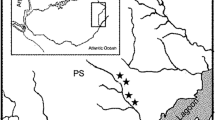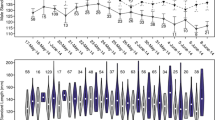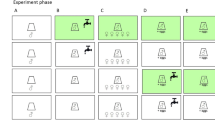Summary
In order to understand the causes of sexual dimorphism, mate choice and size-related fecundity were studied in two pipefish species, Syngnathus typhle and Nerophis ophidion. Sexual dimorphism is more pronounced in N. ophidion; females are larger, have sexual colourings, and are more active during courtship. In S. typhle the sexes are alike in all these respects. Males brood their offspring in both species. In N. ophidion fecundity was positively correlated with both body size and the amount of sexual colouring in females. In males no correlation between body size and fecundity, or between body size and embryo size existed. Predictably, in mate choice experiments with equal-sized females, males chose females with more extensive sexual colourings. We explain sexual dimorphism in this species as a consequence of both natural selection (fecundity increases with size in females but not in males) and sexual selection (males prefer larger females). We argue that sexual size dimorphism did not evolve by selection minimizing overlap in food niches between the sexes, because food production is high in the Zostera beds where the fishes live, and no size dimorphism was found in the sympatrically occurring S. typhle. Furthermore, in N. ophidion dimorphism is not greater in a particular mouth character than in overall body size. In S. typhle egg size and the average number of eggs transferred per spawning were positively correlated with female body size. Apparently more energy per offspring was provided by larger males than by smaller males, and larger males also carried more offspring. As predicted, large mates were preferred by both sexes in mate choice experiments. This is explicable in terms of both natural selection (fecundity increases with size in both sexes) and sexual selection (both sexes prefer large mates). As a consequence of selection acting in the same direction in both sexes, sexual dimorphism is absent in S. typhle.
Similar content being viewed by others
References
Adams SM (1976) The ecology of eelgrass, Zostera marina (L). Fish communities. I Structural analysis. J Exp Mar Biol Ecol 22:269–291
Andersson M (1982) Sexual selection, natural selection and quality advertisement. Biol J Linn Soc 17:375–393
Berglund A, Rosenqvist G, Svensson I (1986) Reversed sex roles and parental investment in zygotes of two pipefish (Syngnathidae) species. Mar Ecol (Progr Ser) 29:209–215
Bischoff RJ, Gould JL, Rubenstein DI (1985) Tail size and female choice in the guppy (Poecilia reticulata). Behav Ecol Sociobiol 17:253–255
Carothers JH (1984) Sexual selection and sexual dimorphism in some herbivorous lizards. Am Nat 124:244–254
Downhower JF, Brown L, Pederson R, Staples G (1983) Sexual selection and sexual dimorphism in mottled sculpins. Evolution 37(1):96–103
Fiedler K (1954) Vergleichende Verhaltensstudien an Seenadeln und Seepferdchen. Z Tierpsychol 11:358–416
Gronell AM (1984) Courtship, spawning, and social organization of the pipefish, Corythoichthys intestinalis (Pisces: Syngnathidae), with notes on two congeneric species. Z Tierpsychol 65:1–24
Gudger EW (1906) The breeding habits and the segmentation of the eggs of the pipefish, Siphostoma floridae. Proc US Nat Mus 29:447–500
Gwynne DT (1981) Sexual difference theory: mormon crickets show role reversal in mate choice. Science 213:779–780
Halliday TR (1978) Sexual selection and mate choice. In: Krebs JR, Davies NB (eds) Behavioural ecology: an evolutionary approach. Sinauer, Sunderland, MA, pp 180–203
Halliday TR (1983) Do frogs and toads choose their mates? Nature 306:226–227
Haresign TW, Schumway SE (1981) Permeability of the marsupium of the pipefish Syngnathus fuscus to (14C)-α-amino isobutyric acid. Comp Biochem Physiol 69A:603–604
Kodric-Brown A, Brown JH (1984) Truth in advertising: the kinds of traits favored by sexual selection. Am Nat 124:309–323
Kronester-Frei A (1975) Licht- und elektronenmikroskopische Untersuchungen am Brutepithel des Männchens von Nerophis lumbriciformis (Pennant 1776), Syngnathidae, unter spezieller Berücksichtigung der strukturellen Veränderung der Eihülle. Forma Functio 8:419–462
Lande R (1981) Models of speciation by sexual selection on polygenic traits. Proc Nat Acad Sci USA 78:3721–3725
Muller M, Osse JWM (1984) Hydrodynamics of suction feeding in fish. Trans Zool Soc Lond 37:51–135
Noble GK (1938) Sexual selection among fishes. Biol Rev 13:133–158
Rauther M (1925) Die Syngnathiden des Golfes von Neapel. Fauna e Flora del Golfo di Napoli. Monographie 36
Ridley M (1983) The explanation of organic diversity. The comparative method and adaptations for mating. Oxford Science Publications, Oxford
Searcy WA (1982) The evolutionary effects of mate selection. Annu Rev Ecol Syst 13:57–85
Slatkin M (1984) Ecological causes of sexual dimorphism. Evolution 38:622–630
Temeles EJ (1985) Sexual size dimorphism of bird-eating hawks: the effect of prey vulnerability. Am Nat 125:485–499
Tinkle DW, Wilbur HM, Tilley SG (1970) Evolutionary strategies in lizard reproduction. Evolution 24:55–74
Tollestrup K (1982) Growth and reproduction in two closely related species of leopard lizards, Gambelia silus and Gambelia wislizenic. Am Midl Nat 108:1–20
Trivers RL (1972) Parental investment and sexual selection. In: Campbell B (ed) Sexual selection and the descent of man, 1871–1971. Aldine, Chicago, pp 136–179
Wade MJ, Arnold SJ (1980) The intensity of sexual selection in relation to male sexual behaviour, female choice, and sperm precedence. Anim Behav 28:446–461
Wootton RJ (1979) Energy costs of egg production and environmental determinants of fecundity in teleost fishes. Symp Zool Soc Lond 44:133–159
Author information
Authors and Affiliations
Rights and permissions
About this article
Cite this article
Berglund, A., Rosenqvist, G. & Svensson, I. Mate choice, fecundity and sexual dimorphism in two pipefish species (Syngnathidae). Behav Ecol Sociobiol 19, 301–307 (1986). https://doi.org/10.1007/BF00300646
Received:
Accepted:
Issue Date:
DOI: https://doi.org/10.1007/BF00300646




